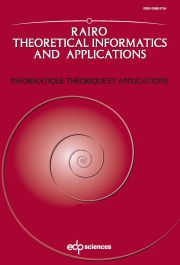Crossref Citations
This article has been cited by the following publications. This list is generated based on data provided by
Crossref.
Mereghetti, Carlo
and
Palano, Beatrice
2001.
Theoretical Computer Science.
Vol. 2202,
Issue. ,
p.
123.
Mereghetti, Carlo
and
Palano, Beatrice
2002.
On the Size of One-way Quantum Finite Automata with Periodic Behaviors.
RAIRO - Theoretical Informatics and Applications,
Vol. 36,
Issue. 3,
p.
277.
Gramlich, Gregor
2003.
Mathematical Foundations of Computer Science 2003.
Vol. 2747,
Issue. ,
p.
460.
BERTONI, ALBERTO
MEREGHETTI, CARLO
and
PALANO, BEATRICE
2003.
GOLOMB RULERS AND DIFFERENCE SETS FOR SUCCINCT QUANTUM AUTOMATA.
International Journal of Foundations of Computer Science,
Vol. 14,
Issue. 05,
p.
871.
Bertoni, Alberto
Mereghetti, Carlo
and
Palano, Beatrice
2005.
Small size quantum automata recognizing some regular languages.
Theoretical Computer Science,
Vol. 340,
Issue. 2,
p.
394.
Mereghetti, Carlo
and
Palano, Beatrice
2006.
Quantum finite automata with control language.
RAIRO - Theoretical Informatics and Applications,
Vol. 40,
Issue. 2,
p.
315.
Mereghetti, Carlo
and
Palano, Beatrice
2007.
Quantum automata for some multiperiodic languages.
Theoretical Computer Science,
Vol. 387,
Issue. 2,
p.
177.
Zheng, Shenggen
Qiu, Daowen
Li, Lvzhou
and
Gruska, Jozef
2012.
Languages Alive.
Vol. 7300,
Issue. ,
p.
273.
Bianchi, Maria Paola
Mereghetti, Carlo
and
Palano, Beatrice
2014.
Computing with New Resources.
Vol. 8808,
Issue. ,
p.
161.
Zheng, Shenggen
Gruska, Jozef
and
Qiu, Daowen
2014.
Language and Automata Theory and Applications.
Vol. 8370,
Issue. ,
p.
601.
Bednárová, Zuzana
Geffert, Viliam
Mereghetti, Carlo
and
Palano, Beatrice
2014.
Removing nondeterminism in constant height pushdown automata.
Information and Computation,
Vol. 237,
Issue. ,
p.
257.
Zheng, Shenggen
and
Qiu, Daowen
2014.
Computing with New Resources.
Vol. 8808,
Issue. ,
p.
231.
Villagra, Marcos
and
Yamakami, Tomoyuki
2015.
Descriptional Complexity of Formal Systems.
Vol. 9118,
Issue. ,
p.
280.
Gainutdinova, Aida
and
Yakaryılmaz, Abuzer
2015.
Developments in Language Theory.
Vol. 9168,
Issue. ,
p.
252.
Bianchi, Maria Paola
Mereghetti, Carlo
and
Palano, Beatrice
2017.
Quantum finite automata: Advances on Bertoni's ideas.
Theoretical Computer Science,
Vol. 664,
Issue. ,
p.
39.
Gainutdinova, Aida
and
Yakaryılmaz, Abuzer
2018.
Unary probabilistic and quantum automata on promise problems.
Quantum Information Processing,
Vol. 17,
Issue. 2,
Kutrib, Martin
Malcher, Andreas
Mereghetti, Carlo
and
Palano, Beatrice
2020.
Descriptional Complexity of Formal Systems.
Vol. 12442,
Issue. ,
p.
117.
Mereghetti, Carlo
Palano, Beatrice
Cialdi, Simone
Vento, Valeria
Paris, Matteo G. A.
and
Olivares, Stefano
2020.
Photonic realization of a quantum finite automaton.
Physical Review Research,
Vol. 2,
Issue. 1,
Bhatia, Amandeep Singh
and
Zheng, Shenggen
2020.
A Quantum Finite Automata Approach to Modeling the Chemical Reactions.
Frontiers in Physics,
Vol. 8,
Issue. ,
Kutrib, Martin
Malcher, Andreas
Mereghetti, Carlo
and
Palano, Beatrice
2021.
SOFSEM 2021: Theory and Practice of Computer Science.
Vol. 12607,
Issue. ,
p.
218.
 , with $p_1^{\alpha_1}p_2^{\alpha_2} \cdots p_s^{\alpha_s}$
, with $p_1^{\alpha_1}p_2^{\alpha_2} \cdots p_s^{\alpha_s}$  being the factorization of m. To prove this result, we give a general state lower bound for accepting unary languages with isolated cut point on the one-way probabilistic model. Moreover, we exhibit one-way quantum finite automata that, for any m, accept L m with isolated cut point and only two states. These results are settled within a survey on unary automata aiming to compare the descriptional power of deterministic, nondeterministic, probabilistic and quantum paradigms.
being the factorization of m. To prove this result, we give a general state lower bound for accepting unary languages with isolated cut point on the one-way probabilistic model. Moreover, we exhibit one-way quantum finite automata that, for any m, accept L m with isolated cut point and only two states. These results are settled within a survey on unary automata aiming to compare the descriptional power of deterministic, nondeterministic, probabilistic and quantum paradigms.

